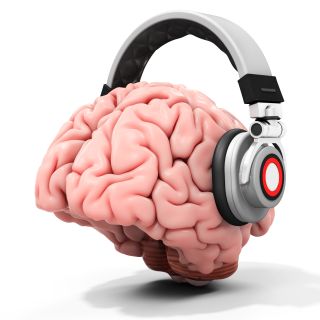Executive Function
3 Minutes of Grooving to the Music Could Make You Smarter
Moving to a beat for three minutes boosts brain power.
Updated January 31, 2024 Reviewed by Jessica Schrader
Key points
- High beats per minute music doesn't affect everyone the same way; it's more enjoyable for "groove enjoyers."
- Groove enjoyers are energized by pulsating tempos; their bodies automatically synchronize to a song's rhythm.
- Groove enjoyers' prefrontal cortex activity and executive functions benefit by moving their bodies to a beat.

When the drummer starts beatin' that beat, he nails that beat with the syncopated rhythm and the rat, tat, tat, tat, tat, tat on the drums. // Turn the beat around (I'm talkin' about the beat). Love to hear percussion. Makes me wanna move my body. Yeah, yeah, yeah. —Vicki Sue Robinson, "Turn the Beat Around" (1976)
Neuroscientists in Japan have been investigating the impact of groove rhythm exercise (GREX) on prefrontal cortex activity and executive function. In 2022, they discovered that GREX only seems to stimulate prefrontal cortex activity in cognition-enhancing ways if the person listening to a bop while exercising is a so-called "groove enjoyer" who's energized by rhythm and automatically gets "into the groove."
Dancing to a Beat for 3 Minutes May Have Brain Benefits
This University of Tsukuba research team's latest study (Fukuie et al., 2023) focused on how long it takes for a groove enjoyer to reap the benefits of moving their body to a beat and if relatively easy cardio (i.e., not huffing and puffing while working out) was enough to trigger the brain benefits of groove rhythm exercise.

On average, their findings suggest that just three minutes of very light-intensity physical activity (30% VO² peak)—equivalent to the cardiorespiratory effort required to walk casually or dance to some low-impact TikTok videos for three minutes—is enough to stimulate dorsolateral prefrontal cortex (DLPFC) activity and improve executive function as indexed by color-word Stroop task scores.
Excitement and Audiomotor Entrainment Are Key
The most recent study by Fukuie et al. builds on their previous research by identifying two specific psychological responses to groove rhythms that predict GREX's effect on prefrontal cortex activity and executive function.
Feelings of excitement coupled with a sense of "audiomotor entrainment" when a groove enjoyer's body movements synchronize with a beat are directly linked to groove rhythm exercise's potential brain-boosting power.
Notably, study participants who weren't "groove enjoyers" and didn't feel a sense of excitement or audiomotor entrainment while doing cardio to a rhythmic song did not score higher on executive function tests and didn't show increased l-DLPFC activity after three minutes of low-intensity GREX.
Are You a Groove Enjoyer?
If listening to music with a pronounced rhythmic groove elicits a sense of increased excitement and a song's rhythm resonates in a way that instinctively makes you want to tap your feet, snap your fingers, bop your head, or move your body in time with the song's tempo, odds are you're a groove enjoyer.
Not everyone gets excited by music with a strong beat. Some people don't feel the uncontrollable itch to "get into the groove" or as if they "can't not" move to the beat when they hear a rhythmic song.
For example, my older sister isn't a groove enjoyer, but I am. We grew up in the 1970s during the disco craze, listening to the same Top 40 music. However, whereas chart-topping songs from 1976 like "Turn the Beat Around" by Vicki Sue Robinson and "You Should Be Dancing" by the Bee Gees always caused my body to start moving uncontrollably to their disco rhythms, these boppy dance songs left my sister bored and uninspired.
To this day, my older sister prefers listening to podcasts or books on tape while doing cardio and doesn't get into GREX. Conversely, I prefer hearing upbeat music at about 120-135 beats per minute (BPMs) when doing cardio and love groove rhythm exercise.
For groove enjoyers, listening to groove-rhythm music during very easy, light-intensity physical activity can have multiple benefits, such as cultivating positive emotions, fueling motivation, stimulating prefrontal cortex activity, and improving executive function.
For those who don't really get into the groove, other studies suggest that moderate-to-vigorous physical activity (MVPA) or high-intensity interval training (HIIT) can provide similar brain benefits regardless of whether or not you're listening to music.
Take-Home Message
Groove rhythm exercise (GREX) enhances executive function and prefrontal activity in groove enjoyers who experience subjective feelings of excitement and audiomotor entrainment when their bodies start moving to a beat. According to the latest (2023) research, positive psychological responses observed in groove enjoyers predict the impact of moving to a beat on someone's prefrontal cortex function.
As Takemune Fukuie and co-authors conclude, "These findings, together with previous results, support the hypothesis that groove rhythm allows us to boost the cognitive benefits of exercise via l-DLPFC activity only in those who enjoy groove, and suggest that subjective audiomotor entrainment is a key mechanism of this boosting effect."
References
Takemune Fukuie, Kazuya Suwabe, Satoshi Kawase, Takeshi Shimizu, Genta Ochi, Ryuta Kuwamizu, Yosuke Sakairi, Hideaki Soya. "Groove Rhythm Enhances Exercise Impact on Prefrontal Cortex Function in Groove Enjoyers." Neuroscience (First published: September 05, 2023 DOI: 10.1016/j.neuroscience.2023.08.039
Takemune Fukuie, Kazuya Suwabe, Satoshi Kawase, Takeshi Shimizu, Genta Ochi, Ryuta Kuwamizu, Yosuke Sakairi, Hideaki Soya. "Groove Rhythm Stimulates Prefrontal Cortex Function in Groove Enjoyers." Scientific Reports (First published: May 05, 2022) DOI: 10.1038/s41598-022-11324-3




